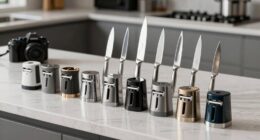Training a deaf and blind dog can be a challenge that requires patience and perseverance. It may seem overwhelming to navigate the world without sight or sound, but with the proper techniques and empathy, significant progress can be achieved.
By focusing on alternative communication methods and building a strong bond, you can unlock the potential within your special companion. But how exactly can you embark on this journey of training a dog with such sensory limitations?
Let's uncover the essential steps together to pave the way for success in this remarkable endeavor.
Key Takeaways
- Use touch, scent, and vibration cues for communication and training.
- Incorporate positive reinforcement techniques with high-value treats.
- Create a safe and enriched environment with consistent routines.
- Seek professional guidance from experienced trainers for tailored support.
Understanding Your Dog's Unique Needs
Understanding the sensory world of a deaf and blind dog is essential for providing effective care and training. Deaf and blind dogs heavily rely on touch cues, scent cues, and vibration cues to navigate their surroundings and communicate. Their sensory limitations require a unique approach to training, emphasizing positive reinforcement and a safe environment. Consistency is key in helping them feel secure and confident.
Creating a safe space for your deaf and blind dog is crucial for their well-being. Eliminate hazards and establish a predictable routine to help them feel at ease. When training, utilize touch cues to communicate commands and offer positive reinforcement to encourage desired behaviors. Patience and understanding are vital as they learn to interpret these cues.
Scent cues can also be used to help them understand their environment, and incorporating vibration cues into training techniques can further enhance communication. By acknowledging and adapting to their unique needs, you can build a strong bond based on trust and effective communication.
Establishing Communication Methods

To effectively establish communication methods with a deaf and blind dog, prioritize utilizing touch cues, scent trails, and vibration signals as key components. As your dog relies heavily on their sense of touch and smell, these methods are crucial for safe communication and building trust.
Use gentle taps or specific touches to convey commands and provide reassurance. Creating scent trails or using markers in your home will help your dog navigate their surroundings with ease. Additionally, introducing vibration cues for different actions can enhance your dog's understanding and response to your signals.
Consistency is key when developing communication methods, ensuring your dog can rely on these cues to interact with their environment confidently. Through trust-building exercises and positive reinforcement, you can strengthen your bond with your dog, making the communication process smoother and more effective.
Implementing Positive Reinforcement Techniques

To further strengthen your communication and training with a deaf and blind dog, incorporating positive reinforcement techniques is essential for encouraging desired behaviors effectively. Here are some key strategies to help you in this process:
- Utilize Positive Reinforcement: Use a reward system with high-value treats to reinforce good behavior during training sessions. This method helps your dog associate positive outcomes with specific actions.
- Establish a Consistent Routine: Dogs, especially those with special needs, thrive on predictability. By maintaining a consistent schedule, you provide structure and security for your furry companion, making it easier for them to understand expectations.
- Seek Guidance from Experienced Trainers: Training a deaf and blind dog can present unique challenges. Consulting with professionals who've experience working with special needs dogs can offer valuable insights and support to ensure you're using the most effective techniques for your pet's specific needs.
Creating a Safe and Enriched Environment

Creating a safe and enriched environment for your deaf and blind dog involves thoughtful consideration of their unique sensory needs and physical limitations. To ensure your furry companion feels secure and stimulated, there are several strategies you can implement.
| Strategies | Description | Benefits |
|---|---|---|
| Tactile markers | Use textured mats or rugs to help your dog navigate safely and distinguish different areas. | Enhances spatial awareness. |
| Consistent living environment | Keep furniture and objects in the same place to avoid confusion and promote familiarity. | Reduces stress and disorientation. |
| Scent cues | Establish scented markers to designate important areas or objects for your dog to recognize. | Aids in location and object recognition. |
| Safe sleeping area | Provide a comfortable sleeping area with familiar scents to promote relaxation and security. | Improves quality of rest and comfort. |
| Baby gates | Implement barriers to prevent access to dangerous areas and ensure your dog's safety. | Prevents accidents and promotes safety. |
Seeking Professional Guidance if Needed

If your deaf and blind dog presents challenges beyond your expertise, seeking guidance from professional trainers or behaviorists can provide invaluable support in tailoring a training plan that meets your dog's specific needs.
Here are three important steps to consider when seeking professional help:
- Consult with a certified dog trainer: Look for experts experienced in working with deaf and blind dogs. They can help you develop a personalized training plan that takes into account your dog's unique sensory impairments.
- Seek guidance from a veterinary behaviorist: If your dog displays challenging behaviors that you find difficult to manage, consulting with a veterinary behaviorist or animal behavior specialist can offer specific insights and strategies to address these issues effectively.
- Enroll in specialized training classes: Consider joining training classes or workshops designed for dogs with sensory impairments. These classes can provide you with valuable tools and techniques tailored to the needs of deaf and blind dogs, helping you navigate the training process more confidently.
Frequently Asked Questions
How Do You Train a Blind and Deaf Dog?
To train a blind and deaf dog, you rely on touch cues, scent trails, and tactile guidance. Using patience and consistency, guide them gently with vibrations or light cues for attention. Your caring approach will help them learn effectively.
How Do You Deal With a Blind and Deaf Dog?
When handling a blind and deaf dog, stay patient and use touch cues. Establish scent trails for navigation and consider vibration collars for commands. Maintain routine and seek professional guidance. Consistency and care are key to nurturing their trust and well-being.
How Do You Potty Train a Blind and Deaf Dog?
To potty train a blind and deaf dog, establish a consistent routine, use tactile cues for the potty area, reward successful behavior, monitor for signs, and provide ample opportunities for breaks. Stay patient, be consistent, and celebrate progress.
How Do You Wake up a Blind and Deaf Dog?
To wake up a blind and deaf dog gently, softly touch their body to signal it's time to wake up. Consistent routines and gentle cues create a secure waking environment. Use specific scents or vibrations as cues for a calm awakening.
Can the Training Techniques for a Deaf and Blind Dog be Applied to a Blind and Deaf Puppy for Potty Training?
Potty training a blind and deaf puppy can be challenging, but the techniques used for training a deaf and blind dog can be applied. Consistent routines, using touch and scent cues, and reward-based methods are effective. Patience and understanding the puppy’s unique needs are essential for successful potty training.
Conclusion
In conclusion, training a deaf and blind dog requires patience, creativity, and dedication.
By understanding their unique needs, establishing communication methods, implementing positive reinforcement techniques, creating a safe environment, and seeking professional guidance if needed, you can help your special furry friend thrive.
Remember, with love and consistency, you can build a strong bond with your deaf and blind dog and help them navigate the world with confidence and joy.











